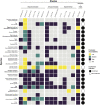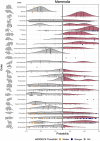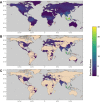This is a preprint.
Predicting the zoonotic capacity of mammals to transmit SARS-CoV-2
- PMID: 33619481
- PMCID: PMC7899445
- DOI: 10.1101/2021.02.18.431844
Predicting the zoonotic capacity of mammals to transmit SARS-CoV-2
Update in
-
Predicting the zoonotic capacity of mammals to transmit SARS-CoV-2.Proc Biol Sci. 2021 Nov 24;288(1963):20211651. doi: 10.1098/rspb.2021.1651. Epub 2021 Nov 17. Proc Biol Sci. 2021. PMID: 34784766 Free PMC article.
Abstract
Back and forth transmission of SARS-CoV-2 between humans and animals may lead to wild reservoirs of virus that can endanger efforts toward long-term control of COVID-19 in people, and protecting vulnerable animal populations that are particularly susceptible to lethal disease. Predicting high risk host species is key to targeting field surveillance and lab experiments that validate host zoonotic potential. A major bottleneck to predicting animal hosts is the small number of species with available molecular information about the structure of ACE2, a key cellular receptor required for viral cell entry. We overcome this bottleneck by combining species' ecological and biological traits with 3D modeling of virus and host cell protein interactions using machine learning methods. This approach enables predictions about the zoonotic capacity of SARS-CoV-2 for over 5,000 mammals - an order of magnitude more species than previously possible. The high accuracy predictions achieved by this approach are strongly corroborated by in vivo empirical studies. We identify numerous common mammal species whose predicted zoonotic capacity and close proximity to humans may further enhance the risk of spillover and spillback transmission of SARS-CoV-2. Our results reveal high priority areas of geographic overlap between global COVID-19 hotspots and potential new mammal hosts of SARS-CoV-2. With molecular sequence data available for only a small fraction of potential host species, predictive modeling integrating data across multiple biological scales offers a conceptual advance that may expand our predictive capacity for zoonotic viruses with similarly unknown and potentially broad host ranges.
Keywords: ACE2; COVID-19; coronavirus; ecological traits; homology modelling; hosts; machine learning; reservoirs; spillback; spillover; susceptibility; zoonotic.
Conflict of interest statement
Competing interests The authors declare no competing interests.
Figures






Similar articles
-
Predicting the zoonotic capacity of mammals to transmit SARS-CoV-2.Proc Biol Sci. 2021 Nov 24;288(1963):20211651. doi: 10.1098/rspb.2021.1651. Epub 2021 Nov 17. Proc Biol Sci. 2021. PMID: 34784766 Free PMC article.
-
Variation in the ACE2 receptor has limited utility for SARS-CoV-2 host prediction.Elife. 2022 Nov 23;11:e80329. doi: 10.7554/eLife.80329. Elife. 2022. PMID: 36416537 Free PMC article.
-
Predicting potential SARS-CoV-2 spillover and spillback in animals.J Microbiol Immunol Infect. 2024 Apr;57(2):225-237. doi: 10.1016/j.jmii.2024.01.002. Epub 2024 Jan 9. J Microbiol Immunol Infect. 2024. PMID: 38262772
-
Interspecies transmission of SARS CoV-2 with special emphasis on viral mutations and ACE-2 receptor homology roles.Int J Vet Sci Med. 2023 Jul 10;11(1):55-86. doi: 10.1080/23144599.2023.2222981. eCollection 2023. Int J Vet Sci Med. 2023. PMID: 37441062 Free PMC article. Review.
-
Animal Models, Zoonotic Reservoirs, and Cross-Species Transmission of Emerging Human-Infecting Coronaviruses.Annu Rev Anim Biosci. 2023 Feb 15;11:1-31. doi: 10.1146/annurev-animal-020420-025011. Annu Rev Anim Biosci. 2023. PMID: 36790890 Review.
References
-
- WHO. WHO coronavirus disease (COVID-19) dashboard. (2021).
-
- Gage K. L. & Kosoy M. Y. Natural history of plague: perspectives from more than a century of research. Annu. Rev. Entomol. 50, 505–528 (2005). - PubMed
-
- Taubenberger J. K. et al. Characterization of the 1918 influenza virus polymerase genes. Nature 437, 889 (2005). - PubMed
Publication types
Grants and funding
LinkOut - more resources
Full Text Sources
Other Literature Sources
Miscellaneous
